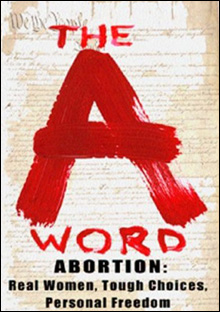 |
Long-time abortion rights advocate Mary Ann Sorrentino didn’t write The A Word to change anyone’s pro-life stance — though she does point out the about-face, in the opposite direction, that both Reagan and the elder Bush made on the issue when they rose to national prominence. Instead she creates an impassioned plea to that 66 percent (or more) of Americans who have repeatedly voted to retain a woman’s right to make decisions about what happens to her own body.
Sorrentino lines up her facts, relates a few “war stories,” ties together the current pieces of the debate — including stem cell research — and repeatedly reminds her readers of why we can’t return to “the bad old days” before 1973’s Roe v. Wade decision. Sorrentino was director of Planned Parenthood of Rhode Island from 1977-87, years when the abortion issue was front and center in the lives of Rhode Islanders as well as the nation. She not only kept the women’s clinic open and secure at a time when just 20 of the country’s 200 Planned Parenthood affiliates were willing to do so, but she was a tireless speaker, outspoken lobbyist, and lively debater on all aspects of women’s reproductive freedom and women’s rights.
Anyone who has lived in Rhode Island for the past 25 years will most likely re¬member that the Diocese of Providence excommunicated Sorrentino from the Catholic Church in 1985 (and threatened to prevent her daughter from being confirmed). Less well-known perhaps is that the Canon Law Society of America overturned that ruling in 1987. When Sorrentino left Planned Parenthood, she took to the airwaves as a talk show host on several local radio stations until 2000. She continues to write newspaper columns for the Standard Times in New Bedford, Massachusetts, and for the Providence Phoenix.
With so much personal history invested in this issue, Sorrentino as an author might have found it hard to pack everything she wanted to say into a 224-page paperback. Though the organization of the book leads to some repetition, the chapters are like the points in any debate, in which the strongest arguments are re-stated, re-shaped, and presented in different contexts.
Here are some of those points: that the liberal left defend their opponents’ right to their views while those opponents try their hardest to silence the pro-choice majority; that the health risks of delivering a baby are 12 times greater than those of a first-trimester abortion, and that 88 to 92 percent of abortions are performed within that time frame; that the “person-hood” assigned to the fetus by the right-to-life believers all-but-denies the “person-hood” of the mother; that the psychological repercussions of an unintended pregnancy are just as difficult, if not more so, when the oft-touted option of adoption is chosen over abortion; that women seeking abortions come from all economic and social strata; that men suffer as well as women when abortions are illegal; and that giving constitutional rights to an unborn fetus would set the legal system up for chaos.
Despite her fervent beliefs on this red-letter topic—the large red “A” on the book’s cover drives home the ongoing “scarlet letter” nature of abortion — Sorrentino carefully avoids polemics. Of course, she brings up the abortion clinic murders, but she doesn’t dwell on them. Nor does she expend too much energy on picking apart the pro-life rhetoric — though she does mention their opposition of birth control, which could prevent many abortions, and their seeming lack of regard for what happens to unwanted children after they are born, especially those at the bottom of the economic ladder.
She cites statistics about maltreated children in child protective services across the country (906,000 in 2005); the numbers of children killed or disabled by Shaken Baby Syndrome; the health care and legal costs of so many maltreated children; and the fact that life expectancy in the US is below that of Japan, China, and the European Union. She urges pro-choice advocates to work for a maternal and child health package that would safeguard the total physical and emotional well-being of women and children, including the right to terminate a pregnancy.
Sorrentino’s book is a wake-up call to all women (and men) who have taken their hard-won personal freedoms for granted. She has evoked the faces and fates of the women behind the numbers; she’s told their stories as much as her own. In the process, she’s provided a valuable case-book for pro-choice advocates everywhere.
 Related
Related:
- I had an abortion
Forty percent of American women have abortions by the time they're 45. I'm one of them.
- Quiet warfare
Few have been paying attention to that other ongoing terrorist threat
- After South Dakota
Abortion battles
- Ditched
Did Maine’s US senators betray women during the recent battles for the Supreme Court bench?
- The Pah-ty's ovah
Congressional reps from New England are poised to lead the attack on Republican waste and fraud
- Hard sell
Kerry Healey says she’s a social moderate. Should we believe her?
- Less

 Topics
Topics:
Books
, Abortion
, Planned Parenthood Federation of America
, Health and Fitness
, More  , Abortion
, Planned Parenthood Federation of America
, Health and Fitness
, Medicine
, Sexual and Reproductive Health
, Domestic Policy
, Political Policy
, Politics
, Social Policy
, Abortion Policy
, Less
, Abortion
, Planned Parenthood Federation of America
, Health and Fitness
, Medicine
, Sexual and Reproductive Health
, Domestic Policy
, Political Policy
, Politics
, Social Policy
, Abortion Policy
, Less 